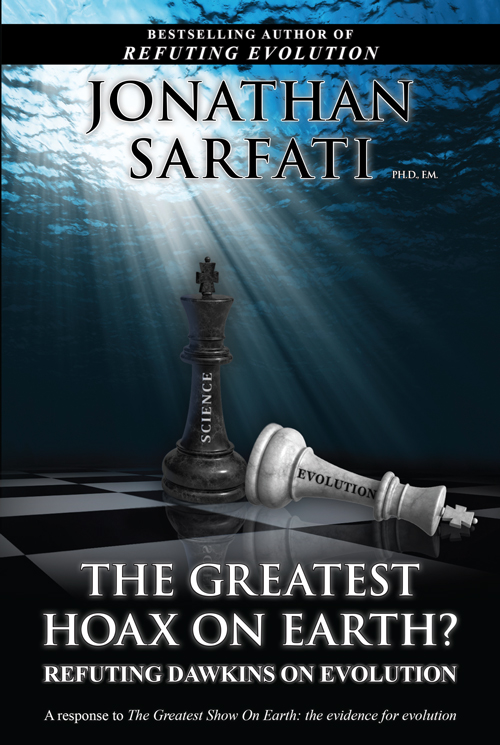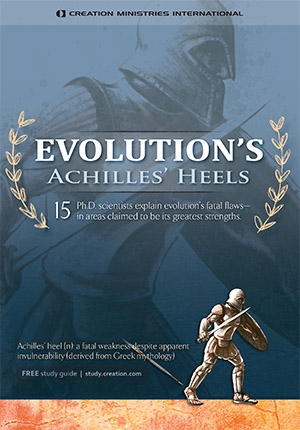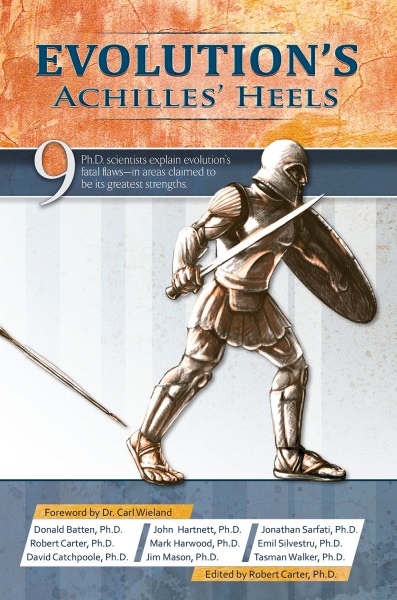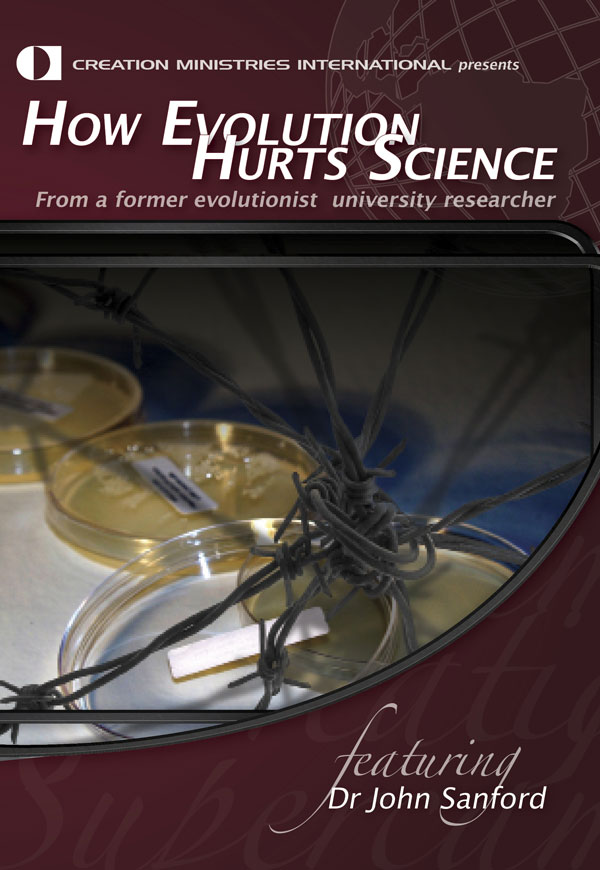Journal of Creation 37(3):73–78, December 2024
Browse our latest digital issue Subscribe
Irresolvable problems with Neo-Darwinism—experts calling for a new theory of evolution
Recently, there have been some surprising confessions from people committed to the prevalent view of origins. This, of course, is neo-Darwinian evolution, the idea that beneficial genetic mutations arising over deep time have provided the raw material for Darwinian natural selection. In this manner, evolutionists say that random errors in the DNA, coupled with the survival of the fittest, have generated every living organism on the planet, from diatoms to dunnocks, yeasts to yaks, and pneumococci to naval architects. The headings in this article are all direct quotations from evolutionists that have appeared recently.
“Most of our evolutionary trees could be wrong”
In June 2022, the University of Bath (UK) issued a press release from Professor Matthew Wills and colleagues, provocatively titled, “Study suggests that most of our evolutionary trees could be wrong”.1 Indeed, their published research in Communications Biology really sets a cat among the pigeons.2
Over the last 20 years, evolutionary biologists have increasingly had to face the uncomfortable fact that the data of molecular biology often contradict traditional evolutionary family trees. It is well known that the major way in which evolutionists have grouped living creatures has been according to their anatomical similarities. This, in turn, feeds into arguments about homology. Evolutionary scientists usually start with the assumption that ‘homology is similarity due to common ancestry’. That’s their definition, but it is problematic when they then point to anatomical similarities and argue that these are evidence for common ancestry. Such arguments for homology are blatantly circular (thus are explanation-free) because they are attempts to prove what had already been assumed!3
At the heart of the argument of homology is the idea that similarity of morphology confirms relatedness, but conflicting molecular comparisons among animals are like a spanner in the works. For example, according to research published in 2004, a morphological family tree of mammals has the Xenarthra (creatures like sloths, anteaters, and armadillos) as a very ‘early’ branch of the placental mammals. However, a molecular family tree of the same creatures positions the Xenarthra as having evolved ‘much later’, after a group called the ‘Afrotheria’—which includes elephants, tenrecs, golden moles, elephant shrews, hyraxes, aardvarks, and sea cows.4
If this isn’t striking enough, the latest findings of the Bath research team take things to another level. As well as analyzing the evolutionary trees of 48 groups of animals and plants (comparing morphological family trees with molecular trees), Matthew Wills and colleagues also cross-referenced the data to each creature’s geographical location.2 Nobody had done this before. To their great surprise, “animals grouped together by molecular trees lived more closely together geographically than the animals grouped using the morphological trees”,2 leading Prof Wills to admit:
“… it turns out that we’ve got lots of our evolutionary trees wrong. For over a hundred years, we’ve been classifying organisms according to how they look and are put together anatomically, but molecular data often tells us a rather different story.”1
Just how challenging this finding is for evolution should be obvious if you refer to the pictures of the very different members of the Afrotheria (figure 1), while reading the following:
“For example, tiny elephant shrews, aardvarks, elephants, golden moles and swimming manatees have all come from the same big branch of mammal evolution—despite the fact that they look completely different from one another (and live in very different ways).
“Molecular trees have put them all together in a group called Afrotheria, so-called because they all come from the African continent.” 1
Think about that. The coded instructions of a creature’s DNA are used to make all the proteins which comprise its anatomy. Supposedly, beneficial genetic mutations of this DNA are the raw material that natural selection works with, thereby driving the evolution of new tissues, organs, and body plans. If that is really the case, why the big disagreement between DNA/protein comparisons and the morphological comparisons (ones based on appearance)?
Professor Wills re-emphasized this evolutionary dilemma more recently, once again highlighting his team’s counterintuitive study findings:
“Evolutionary trees based on DNA data were two-thirds more likely to match with the location of the species compared with traditional evolution maps. In other words, previous trees showed several species were related based on appearance. Our research showed they were far less likely to live near each other compared to species linked by DNA data.”5
In other words, such research upsets evolutionary family trees across the board. For a long time, Wills writes, similarities in the brains and skeletons of bats and primates (in which he includes humans) led evolutionists to believe they were close relatives. The molecular data has surprised them all: “Astonishingly, bats turn out to be more closely related to cows, horses and even rhinoceroses than they are to us.”5
“Do we need a new theory of evolution?”
Some evolutionary scientists have dissented from pure Darwinism for decades, giving rise to many alternative theories and models of evolutionary change (see Appendix). However, the neo-Darwinian version of evolution is still by far the most popular. It is still the version that school children learn and that is generally propagated by the mainstream media. Those students of evolution conversant with the trajectory of evolutionary thinking cannot avoid the conclusion that there is something amiss—the proliferation of alternative ideas and models is a big clue.
The entire edifice of evolution has been built upon supposedly similar appearances of organisms, both living and extinct. As we have already seen, the central Darwinian idea that similarity of appearance establishes relationship is being proven wrong. Fossil experts need to face the facts: in one fell swoop, the data from molecular biology is sweeping aside almost two centuries of palaeontological theorizing and popular storytelling. Living organisms frequently share more genetic similarity with very different-looking creatures in the same geographical location than with more morphologically similar ones in a different part of the world. This being the case, of what value are studies that focus on the minutiae of anatomical comparisons between long-extinct creatures, most of them based upon very fragmentary remains, and sometimes on mere bony scraps?
However, it would be naïve to think that this conflict between theory and facts, stupendous though it really is, will cause a fundamental reassessment of the ‘fact’ of evolution itself. Far too much is at stake. There is much more to the origins debate than the factual data of biology, genetics, and palaeontology. For many, evolution is foundational to a worldview that has dispensed with the Creator God. ‘True believers’ have invested too much in the paradigm to question its reality, not just intellectually, but also emotionally, and even spiritually.
Refreshingly, however, more and more scientists are thinking outside the box. Contrary to the slur that they are all closet religious fundamentalists, many of these people have no overt faith commitments. Their concern is to go where the evidence leads. They wish to be unshackled by dogma and are prepared to stand in defiance of those who would restrict freedom of thought and speech in science—whether the intimidating priests of neo-Darwinism or their willing acolytes in the secular media.
For some years now, a growing list of doctoral scientists from academic institutions around the world have signed up to the following statement at the website, A Scientific Dissent From Darwinism:
“We are skeptical of claims for the ability of random mutation and natural selection to account for the complexity of life. Careful examination of the evidence for Darwinian theory should be encouraged.”
At the time of writing, this list exceeds 1,200 Ph.D. scientists, 38% of whom are department professors.6 In spite of their impeccable credentials, critics have tried to write them off as scientific ignoramuses, guilty of muddying the waters over the supposedly clear and abundant evidence for evolution. However, such lame attempts to dismiss this large body of critics of neo-Darwinism have done nothing to shore up the inadequacies of a failing theory.
For some time, in fact, mainstream biological scientists who believe in evolution have been voicing their frustration about the lack of debate about the problems with the standard theory. Finally, it seems, some of these complaints are getting through. In June 2022, The Guardian (UK) even carried an article with the provocative title, “Do we need a new theory of evolution?”. Writer Steve Buranyi pulled no punches:
“[There’s a problem with] the basic story of evolution, as recounted in countless textbooks and pop-science bestsellers. The problem, according to a growing number of scientists, is that it is absurdly crude and misleading.”7
For biblical creationists, exposés like this are encouraging. In spite of the very real conflicts between the facts and evolutionary theory, not to mention the many private disagreements among evolutionary scientists themselves, few have been willing to air these things publicly. Not surprisingly, the average person has assumed all is well. A very telling admission is that a plethora of popular science books, as well as school textbooks, are guilty of “absurdly crude and misleading” evolutionary storytelling. Evolutionary scientists themselves are saying this! Over 20 years ago, James Williams, a trainer of teachers at University of Sussex (UK) similarly bemoaned that “Examples of evolution used in textbooks are flawed and in need of radical updating” and “Our teaching of evolution is poor”.8 The situation is now much worse.
Buranyi did not stop there, however. Drastic problems with neo-Darwinism, the so-called ‘modern synthesis’, were recognized decades ago; i.e. the idea, long championed by the likes of Richard Dawkins, that natural selection sorts out and selects from random mutations. A new generation of evolutionists have long realized that it is not the answer, as Buranyi explains:
“According to the modern synthesis, even if mutations turned out to be common, natural selection would, over time, still be the primary cause of change, preserving the useful mutations and junking the useless ones. But that isn’t what was happening. The genes were changing—that is, evolving—but natural selection wasn’t playing a part. Some genetic changes were being preserved for no reason apart from pure chance. Natural selection seemed to be asleep at the wheel.”7
It is true that genes may change, but none of these instances is of the slightest encouragement for neo-Darwinian evolution. Instead, mutations invariably disrupt and break things. Mutations can lead to new alleles, new versions of existing genes, leading to new traits (although many traits are not the result of mutations). However, mutations have never been observed to generate the sort of novel complexity that neo-Darwinists wish for. Moreover, evolutionists’ confidence in the power of natural selection to help generate functional new features has been misplaced.
Buranyi’s assessment is apt, but again reveals how few experts have the appetite to come clean about the abject failure of neo-Darwinism:
“Perhaps the biggest change from the theory’s mid-[20th] century glory days is that its most ambitious claims—that simply by understanding genes and natural selection, we can understand all life on earth—have been dropped, or now come weighted with caveats and exceptions. This shift has occurred with little fanfare. … no formal reckoning with its failures or schisms has occurred [emphases added].”7
“Neo-Darwinism must mutate to survive”
Two months after the Guardian article, U.S. co-authors and professors Olen R. Brown and David A. Hullender joined the fray with a paper titled, ‘Neo-Darwinism must mutate to survive’.9 They are adamant that the small-scale changes observed in the natural world, often dubbed ‘microevolution’, are of absolutely no help in explaining the imagined large-scale changes purported by Charles Darwin and his successors. Coming at things from a different angle, Brown and Hullender highlight the fact that the statistical improbability of neo-Darwinism is in the order of 10–50, putting the theory’s ability to account for genuinely novel complexity (macro changes) into the realm of the impossible:
“Thus, survival of the fittest is illogical when proposed as adequate for selecting the origination of all complex, major, new body-types and metabolic functions because the multiple changes in multiple genomes that are required have intermediate stages without advantage; selection would not reasonably occur, and disadvantage or death would logically prevail.”9
This is yet another strike against the cherished theory, and this is seriously confronting for proponents of naturalism. What, then, is the alternative, if mutation and selection cannot produce significant evolutionary change? Could there be purpose in biology, ‘Intelligent Design’? That, of course, has long been a big no-no for a majority of scientists. Consequently, it is refreshing to see Brown and Hullender saying that “Logic demands that it [evolution] be open to investigation. This first requires an openness to ideas and science must be open to new ideas.”9
Moreover, while not using Michael Behe’s famous phrase, Brown and Hullender acknowledge the serious challenge that ‘irreducible complexity’ poses for large-scale evolutionary change:
“Darwin wrote in On the Origin of Species … : ‘If it could be demonstrated that any complex organ existed, which could not possibly have been formed by numerous, successive, slight modifications, my theory would absolutely break down. But I can find out no such case.’ Today, Darwin’s missing cases are abundant including each complex transition to a new body type, metabolic cycle, or metabolic chain. Multi-step processes are routinely required at every evolutionary step.”9
“Darwin got it wrong”
One could be forgiven for thinking, from this recent flurry of high-profile admissions, that all is not well with the theory of evolution, that these sorts of admissions are new. In fact, there have been murmurings for quite some time. For instance, in their book What Darwin Got Wrong (2011), Jerry Fodor and Massimo Piattelli-Palmarini say that Darwinism is “fatally flawed”, stating candidly:
“‘OK; so if Darwin got it wrong, what do you guys think is the mechanism of evolution?’ Short answer: we don’t know what the mechanism of evolution is. As far as we can make out, nobody knows exactly how phenotypes evolve.”10
“In fact, we don’t know very well how evolution works. Nor did Darwin and nor (as far as we can tell) does anybody else.”11
The opinions of writers of their stature are not easily dismissed. Now retired, Fodor is a respected American philosopher whose career included long stints at Massachusetts Institute of Technology, City University of New York, and Rutger University. Piattelli-Palmarini’s career has taken in biophysics, molecular biology, and he is currently Professor of Linguistics and Cognitive Science at the University of Arizona. They can’t be justly accused of having a pro-teleological bias of some sort. Rather, “we do want, ever so much, to be secular humanists. In fact, we both claim to be outright, card-carrying, signed-up, dyed-in-the-wool, no-holds-barred atheists. We therefore seek thoroughly naturalistic explanations of the facts of evolution.”12
In the 2011 edition of What Darwin Got Wrong (first published in 2010), Fodor and Piattelli-Palmarini included an extra chapter, ‘Afterword and reply to the critics’, confiding that “the book was received very badly [by their evolutionary colleagues]. Almost (though not quite) all the reviews were hostile and some were hysterical.”13 Nevertheless, in the years that followed, more scientists have shown themselves willing to raise their heads above the parapet.
In 2013, Carrie Arnold, a science writer for New Scientist, showed unusual candour by emphasizing something that creationist biologists had been pointing out for a long time:
“While natural selection explains how species change over time, accounting for how new species arise in the first place has proved rather trickier. Darwin’s On the Origin of Species actually said nothing at all about the origin of species.”14
Had an advocate of biblical creation or intelligent design made the same point, one can easily imagine the accusations and cries of ‘foul’. The same year, Stephen Meyer had this to say in his tour de force of a book, Darwin’s Doubt:
“The technical literature in biology is now replete with world-class biologists routinely expressing doubts about various aspects of neo-Darwinian theory, and especially about its central tenet, namely, the alleged creative power of the natural selection and mutation mechanism [emphasis added].”15
Is it credible that scientists have been unable to flesh out the main claim of the title of Darwin’s famous 1859 book, On the Origin of Species, after a further 160 years of research by a vast number of them? In 2015, biological science writer Bob Holmes admitted:
“Speciation still remains one of the biggest mysteries in evolutionary biology and the unexamined view of natural selection leading to large-scale innovations is not true.”16
“Not true”, notice. Darwin really did get it wrong! The same year, Suzan Mazur interviewed a number of world-leading biologists and published these exchanges in her book, The Paradigm Shifters: Overthrowing the hegemony of the culture of Darwin. We will consider just two of these dissenters from neo-Darwinism.
Firstly, James A. Shapiro (University of Chicago) had this to say:
“Genome change is not the result of accidents. … It’s in the course of fixing damage or responding to other inputs … that cells turn on the systems they have for restructuring their genomes. So what we have is something different from accidents and mistakes as a source of genetic change. We have what I call ‘natural genetic engineering’ [emphasis added].”17
In other words, this professor of biochemistry and molecular biology is adamant that random mutational change is of no help to evolution. Shapiro is another scientist not easily dismissed. As well as stellar academic achievements, he has been awarded an OBE.18
Secondly, the late Mae-Wan Ho (co-founder and director of Institute of Science and Society, UK) was an accomplished geneticist. She was blunt about the status quo as she saw it:
“I think the Modern Synthesis has got to be completely replaced, and unfortunately, those people who are very attached to neo-Darwinism won’t look at the evidence. A lot of them don’t know molecular genetics at all. Or like [Richard] Dawkins, they will say, I just don’t believe it. They’re not scientists.”19
These are just a few of the many voices of scientists, most of them evolutionists, who have been calling for an honest appraisal of the state of evolutionary theory. They strongly believe that a new theory of evolution is desperately needed.
Wishful thinking is no answer
Many others, however, prefer to hide their heads in the sand, holding on to the irrational notion that evolutionary change surely must have occurred, in spite of these apparently insuperable scientific challenges. Maybe we are underestimating evolution’s ability?
“Perhaps evolutionary innovation is easier than we think? Perhaps evolution does not have to wait for innovations? Perhaps its creative engine is more powerful than we give it credit for? The astonishing speed with which evolution can respond to new opportunities suggests this possibility.
“… What if many innovations arise before their time, but flourish only when conditions are right? [emphases added].”20
To which we reply, there is no crime in using one’s imagination, but ‘perhaps’ and ‘what if’ are not acceptable substitutes for tried-and-tested scientific discoveries.
The real answer to the question posed by this article is ‘no, a new theory of evolution is not needed’. Instead, evolutionists ought to stand back and ask themselves: ‘if neo-Darwinian evolution has been falsified (and Darwin and his followers are wrong), why am I so driven to find an alternative naturalistic explanation for origins?’ What is wrong with acknowledging that living things show profound evidence of intelligent design, and indeed were designed to adapt? Why not follow the evidence where it leads?
Appendix: The evolution of evolutionary theory
What follows is a chronological list of different evolutionary theories that the author has become aware of and studied since the late 1980s. It is not exhaustive; further theories are given at the end of these ten items:
- Darwinism (1859, Charles Darwin). The standard view of natural selection, prior to the advent of genetics and knowledge about genetic mutations.
- Social Darwinism (a term first used in 1877, but more popular in the post WWII period). It has links with the early eugenics movement and is the attempted application of evolution to human sociology and politics.
- Neo-Darwinism (late 1930s, later dubbed ‘evolution by creeps’ by Gould, in response to those who criticised his and Niles Eldredge’s Punctuated Equilibrium model, see below). It is the result of the synthesis of classical Darwinism with genetics (the idea of mutations as the source of novelty). There have been numerous prominent advocates: Theodosius Dobzhansky, Ronald Fisher, John B.S. Haldane, Ernst Mayr, George Gaylord Simpson, and more. Richard Dawkins and Jerry Coyne are just two of today’s advocates. Sympatric and allopatric speciation are key ideas within this model.
- Hopeful Monster hypothesis (1940, Richard Goldschmidt, his own term for his idea!). A kind of saltational evolutionary theory that involves large mutations in order to bridge the perceived gulf between micro- and macroevolution.
- Punctuated Equilibrium (1970s, dubbed ‘evolution by jerks’ by its critics), including allopatric speciation as a central idea. Key advocates: Stephen Jay Gould and Niles Eldredge.
- Symbiogenesis (an old term, from 1926). It was made into a full-blown evolutionary theory by Lynn Margulis (1938–2011) while she was a post-doctoral scientist, but especially following her books in 1998 and 2002. She became well known from the early 1970s after publishing her endosymbiosis theory to explain the origin of mitochondria and chloroplasts from mergers of various prokaryotic organisms.
- Neutral Theory (1960s). The key advocate was Motoo Kimura (Japanese; mentioned in John Sanford’s book, Genetic Entropy & the Mystery of the Genome); see also Kimura’s influential 1983 C.U. Press book, The Neutral Theory of Molecular Evolution.
- Evo-Devo (or evolutionary development). It is not easy to give a date as this includes many ideas and discoveries stretching back a century. Since the 1980s, the discovery and subsequent elucidation of the function of Hox (homeotic, homeobox) genes has been a key part of Evo-Devo. In the thinking of many biologists, it is now a strong contributory factor to large-scale evolutionary change. Well-known advocates are Sean B. Carroll and Jack Horner.
- Natural Genetic Engineering (2011 book, Evolution: A view from the 21st Century, James Shapiro); a second edition appeared in 2022. To borrow from one of the chapter titles of the book, it is a ‘systems approach to generating functional novelty’. James Shapiro explicitly denies that random mutation and natural selection are capable of large scale evolutionary change; e.g. “The role of selection is to eliminate evolutionary novelties that prove to be non-functional and interfere with adaptive needs. Selection operates as a purifying but not creative force [emphasis added].”21
- Complexity by Subtraction (a 2013 paper in Evolutionary Biology22) is an attempt to get round the challenges of irreducible complexity (Michael Behe). Proponents: Daniel McShea and Wim Hordijk.
In addition, Andrew Lamb has helpfully listed the following online:
“Other (mostly discarded) theories of evolution include Maximum Entropy Production (MEP), Population Dynamics, Facilitated Variation, Semi-Meiosis, Niche Construction, Panspermia, Metabolic Rate Theory, Zoogenesis, Lamarckism, Orthogenesis, Pangenesis, Gaia Theory, Evo-Devo, Symbiogenesis. There are many more.”23
References and notes
- University of Bath, Study suggests that most of our evolutionary trees could be wrong, phys.org, 1 Jun 2022. Return to text.
- Oyston, J.W., Wilkinson, M., Ruta, M., and Wills, M.A., Molecular phylogenies map to biogeography better than morphological ones, Communications Biology 5:521, 31 May 2022. Return to text.
- A good discussion of this is in chapter 4 of: Wells, J., Icons of Evolution: Science or myth?, Regnery Publishing, Washington DC, pp. 59–66, 2002. Return to text.
- Springer, M.S. et al., Molecules consolidate the placental mammal tree, Trends in Ecology and Evolution 19:430–438, 2004. Return to text.
- Wills, M., Evolutionary tree of life: modern science is showing how we got so much wrong, theconversation.com, 23 Jun 2023. Return to text.
- Dissent from Darwin—there is a scientific dissent from Darwinism and it deserves to be heard, dissentfromdarwin.org; accessed 21 Aug 2023. Return to text.
- Buranyi, S., Do we need a new theory of evolution? theguardian.com, 28 Jun 2022. Return to text.
- Bell, P., Don’t believe evolution—just accept it! creation.com, 19 May 2003. Return to text.
- Brown, O.R. and Hullender, D.A., Neo-Darwinism must mutate to survive, Progress in Biophysics and Molecular Biology 172:24–38, Aug 2022 | doi:10.1016/j.pbiomolbio.2022.04.005. Return to text.
- Fodor, J. and Piattelli-Palmarini, M., What Darwin Got Wrong, Profile Books, London, p. 153, 2011. Return to text.
- Fodor and Piattelli-Palmarini, ref. 10, p. xvi. Return to text.
- Fodor and Piattelli-Palmarini, ref. 10, ref. 10, p. xv. Return to text.
- Fodor and Piattelli-Palmarini, ref. 10, p. 167. Return to text.
- Arnold, C., The other you: The microbes living inside us don’t just play a vital role in our health—they also shape our evolution, New Scientist 217(2899):30–34, 12 Jan 2013. Return to text.
- Meyer, S.C., Darwin’s Doubt: The explosive origin of animal life and the case for Intelligent Design, HarperCollins, p. x, 2013. Return to text.
- Holmes, B., The accident of species; in: Michael Brooks (Ed.), Chance: The science and secrets of luck, randomness and probability, Profile/New Scientist, London, pp. 34–35, 2015. Return to text.
- Quoted in: Mazur, S., The Paradigm Shifters: Overthrowing ‘the hegemony of the culture of Darwin’, Caswell Books, New York, p. 15, 2015. Return to text.
- Queen Elizabeth II awarded him the Order of the British Empire (OBE) in 2002 for his significant role in promoting distinguished young Americans to Marshall Scholarships in British universities. Return to text.
- Mazur, ref. 17, p. 44. Return to text.
- Wagner, A., Sleeping beauties: the evolutionary innovations that wait millions of years to come good, theguardian.com, 18 Apr 2023. Return to text.
- A technical review of the book can be found at: Wilkins, A.S., Genome Biol Evol 4(4):423–426, 24 Jan 2012. Return to text.
- McShea, D.W. and Hordijk, W., Complexity by subtraction, Evolutionary Biology 40:504–520, 13 Apr 2013. Return to text.
- Lamb, A., Braterman ‘slam dunk’ flunk, creation.com, 28 Nov. 2017. Return to text.










Readers’ comments
Comments are automatically closed 14 days after publication.